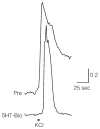Parallel processing in mammalian taste buds?
- PMID: 19371753
- PMCID: PMC3717265
- DOI: 10.1016/j.physbeh.2009.04.003
Parallel processing in mammalian taste buds?
Abstract
ROPER, S.D. Parallel processing in mammalian taste buds? Physiol Behav XXX(Y) 000-000, 2009. There is emerging evidence that two parallel lines of gustatory information are generated in taste buds. One pathway leads to higher cortical centers and is involved in discriminating basic taste qualities (sweet, bitter, sour, salty, umami) and perceiving flavors. The other pathway may conduct information involved in physiological reflexes such as swallowing, salivation, and cephalic phase digestion. If this notion is true, the existence of two populations of taste bud cells that have different functional characteristics may lie at the origins of the two pathways. This speculative concept is explored in this review of taste signal processing in mammalian taste buds.
Figures




Similar articles
-
Signal transduction and information processing in mammalian taste buds.Pflugers Arch. 2007 Aug;454(5):759-76. doi: 10.1007/s00424-007-0247-x. Epub 2007 Apr 28. Pflugers Arch. 2007. PMID: 17468883 Free PMC article. Review.
-
Breadth of tuning and taste coding in mammalian taste buds.J Neurosci. 2007 Oct 3;27(40):10840-8. doi: 10.1523/JNEUROSCI.1863-07.2007. J Neurosci. 2007. PMID: 17913917 Free PMC article.
-
Acid stimulation (sour taste) elicits GABA and serotonin release from mouse taste cells.PLoS One. 2011;6(10):e25471. doi: 10.1371/journal.pone.0025471. Epub 2011 Oct 20. PLoS One. 2011. PMID: 22028776 Free PMC article.
-
Mouse taste buds release serotonin in response to taste stimuli.Chem Senses. 2005 Jan;30 Suppl 1:i39-40. doi: 10.1093/chemse/bjh102. Chem Senses. 2005. PMID: 15738184 No abstract available.
-
How taste works: cells, receptors and gustatory perception.Cell Mol Biol Lett. 2015 Dec;20(5):699-716. doi: 10.1515/cmble-2015-0042. Cell Mol Biol Lett. 2015. PMID: 26447485 Review.
Cited by
-
Taste buds as peripheral chemosensory processors.Semin Cell Dev Biol. 2013 Jan;24(1):71-9. doi: 10.1016/j.semcdb.2012.12.002. Epub 2012 Dec 20. Semin Cell Dev Biol. 2013. PMID: 23261954 Free PMC article. Review.
-
Parallel Social Information Processing Circuits Are Differentially Impacted in Autism.Neuron. 2020 Nov 25;108(4):659-675.e6. doi: 10.1016/j.neuron.2020.10.002. Epub 2020 Oct 27. Neuron. 2020. PMID: 33113347 Free PMC article.
-
An alternative pathway for sweet sensation: possible mechanisms and physiological relevance.Pflugers Arch. 2020 Dec;472(12):1667-1691. doi: 10.1007/s00424-020-02467-1. Epub 2020 Oct 8. Pflugers Arch. 2020. PMID: 33030576 Review.
-
Sensing Senses: Optical Biosensors to Study Gustation.Sensors (Basel). 2020 Mar 25;20(7):1811. doi: 10.3390/s20071811. Sensors (Basel). 2020. PMID: 32218129 Free PMC article. Review.
-
Spike rate and spike timing contributions to coding taste quality information in rat periphery.Front Integr Neurosci. 2011 May 11;5:18. doi: 10.3389/fnint.2011.00018. eCollection 2011. Front Integr Neurosci. 2011. PMID: 21617730 Free PMC article.
References
-
- Spector AC, Travers SP. The representation of taste quality in the mammalian nervous system. Behav Cogn Neurosci Rev. 2005;4:143–91. - PubMed
-
- Rolls ET. Sensory processing in the brain related to the control of food intake. Proc Nutr Soc. 2007;66:96–112. - PubMed
-
- Lasiter PS, Deems DA, Oetting RL, Garcia J. Taste discriminations in rats lacking anterior insular gustatory neocortex. Physiol Behav. 1985;35:277–85. - PubMed
-
- Rolls ET, Grabenhorst F. The orbitofrontal cortex and beyond: from affect to decision-making. Prog Neurobiol. 2008;86:216–44. - PubMed
MeSH terms
Substances
Grants and funding
LinkOut - more resources
Full Text Sources

